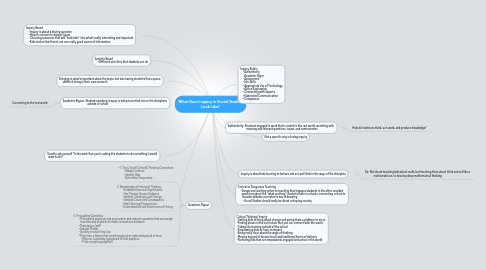What Does Inquiry in Social Studies Look Like?
저자: Amy Gurin

1. Academic Rigour: Students working in ways or behaviours that mirror the disciplines outside of school
1.1. Connecting to the real world
2. Good to ask yourself “Is the work that you’re asking the students to do something I would want to do?
3. Bringing in what’s important about the topic, but also having students find a space within it, bring in their own research
4. Activity Based •Different activities that students can do
5. Inquiry Based •Inquiry is about a driving question •How to connect to deeper issues •Choosing resources that will “hook kids” into what’s really interesting and important •Kids realize that there’s not one really good source of information
6. Academic Rigour
6.1. •1. The Critical (Criterial) Thinking Consortium •Weigh Evidence •Identify Bias •Determine Perspective
6.2. 2. Benchmarks of Historical Thinking •Establish Historical Significance •Use Primary Source Evidence •Identify Continuity and Change •Analyze Cause and Consequence •Take Historical Perspectives •Understand Ethical Dimensions of History
6.3. 3. Throughline Questions •Throughline questions ask provocative and relevant questions that encourage teachers and students to make connections between: •Themselves (self) •Subject Matter •Society in which they live *They have a theme that runs throughout an extended period of time •Kids are constantly going back to that question •Pulls everything together
7. Authenticity: Students engaged in work that is rooted in the real world, wrestling with meaning and relevant questions, issues, and controversies
7.1. How do historians think, act, work, and produce knowledge?
8. Inquiry is about kids learning to behave and act and think in the ways of the discipline
8.1. Ex: Not about teaching kids about math, but teaching them about think and act like a mathematician, to develop deep mathematical thinking
9. Not a specific way of using inquiry
10. Inquiry Rubric •Authenticity •Academic Rigor •Assessment •Life Skills •Appropriate Use of Technology •Active Exploration •Connecting with Experts •Elaborated Communication •Compassion
11. Critical or Dangerous Teaching •Dangerous teaching refers to teaching that engages students in the often unasked questions about the “what and how” students learn in schools, connecting school to broader debates over what is worth knowing •Social Studies should really be about critiquing society
12. Critical Thinking/ Inquiry •Getting kids to bring about change and giving them a platform to do so •Finding places in the curriculum that you can connect with the world •Taking the learning outside of the school •Empowering kids to have an impact •Being really clear about the ways of thinking •Moving beyond of factual recall and traditional forms of delivery •Nurturing kids that are empowered, engaged and active in the world


